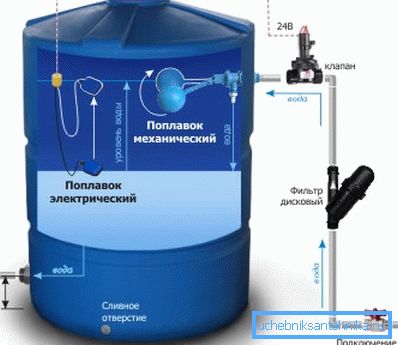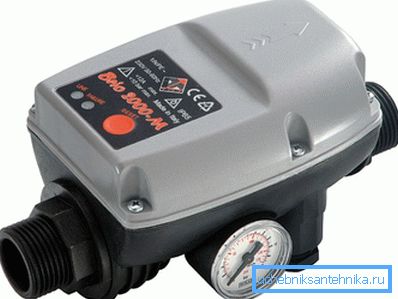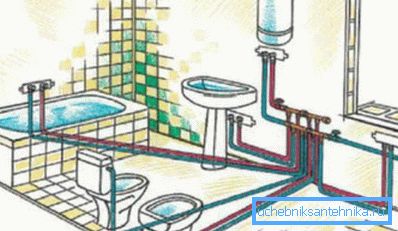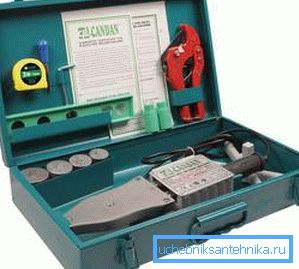To conduct water from the well to the house: how to do it in
When arranging life in a country house or in the country, many of us are faced with the problem of water supply. After all, often the possibility of connecting the site to the central network is missing.
However, an acceptable solution can be found, for example, to bring water into the house from a well drilled in your territory independently. We will talk about how to do this in this article.

How is the water withdrawal from the well

- The well itself, as a rule, is located on the site in the place most suitable for this by geodetic parameters. In addition, the convenience of the implementation of water intake from it and aesthetic considerations. If there is an opportunity to arrange the object so that it does not spoil the landscape of the site - this should be done.
- The entire system of autonomous water supply of the site is divided into 3 components: the site of fluid intake from the aquifer, the street highway and the internal water supply system.
- The last section, in turn, consists of "valves": pipes, valves, adapters, valves and consumer devices - mixers, taps, plumbing fixtures.
- Water is pumped from the bottom using a submersible pump. Its capacity is selected on the basis of the depth and planned performance of the well.
- The mass of devices, descending into the trunk of the object, is quite large. This is the pump itself, as well as the electrical cable and water hose. As a result, the well must be equipped with a mechanism for lowering / lifting.
- You can do it yourself or purchase a ready-made device for a well. The simplest version of the device is an electric or manual winch. On its cable and the pump is hung up. In this case, the actions of two workers are necessary - one stands behind the winch, and his partner puts in or takes the cable and the hose.
Features of the water supply system
Note! For convenience, the pump cable is often fixed to the hose in 1.5 / 2 meter increments. The instruction does not prohibit it. But keep in mind that the mount should not be carried out "tightly." The wire should move relative to the hose when efforts are applied. The important point - the load must be less than those that will threaten damage to the hose, wire.
- There are more complex lifting devices equipped with two / three drums, whose actions are synchronized. The traction device drives the cable, on the other two are located a hose and a cable.
- Water is delivered to the building from the well through the pipeline. It is laid underground, below the level of freezing. When this is, for whatever reason, impossible, water pipes should be securely insulated.
Room for the necessary equipment

All the equipment described above occupies a specific place, needs protection from precipitation, maintenance and periodic maintenance. Proceeding from this, it is necessary to arrange a special room, which is called “pumping”. If the water intake facility is small, then it will be enough to equip the maintenance pit instead of the enclosed space. He will need to be warmed.
Ideally, the water supply system from the well should provide water pressure, which the user can regulate, opening the tap more or less.
Note! For centralized networks, the standard head pressure is 2.5 bar, the maximum figure is 6 bar. For autonomous water supply, you need to try to withstand these indicators. All pipes, valves, sanitary appliances are designed specifically for them.
It should be borne in mind that the pressure level will be constant when the water in the system is supplied in the same quantity as it is consumed. On this basis, the performance of the water supply should correspond to the maximum of your water consumption.
In this case, you can change both interrelated components - and system performance and water consumption. With one caveat - the volume of water that is issued by the well (the so-called “debit”) cannot be changed.
In order to ensure the conditions for the fulfillment of the above approval, it will be necessary to purchase and install sections of the water supply system.
Assembly of external plumbing

The outer pipeline originates in the well itself, more precisely, from a submersible pump.
The interaction of intake and water transport areas
- The water supply system from a well in a private house can be turned on / off by two methods: manually - by a switch, or by means of a control relay connected to a float-type sensor. The sensor must be installed in the tank for water reserves, it will be regulated by the movement of the load on the wire.
- In the case when the volume of water in the tank becomes maximum (it is configured on the sensor), the float pops up, simultaneously opening the contacts. Then the relay is turned on, stopping the pump. If the amount of water in the tank falls below the set mark (as a rule, it is less than 25 percent of the volume of the tank), the float turns, closing the contacts, and the pump starts to work.
- For safety net, for example, if the sensor breaks, an emergency overflow must be installed in the storage tank and brought to the sewage system.
Installation of equipment

- You can purchase a plastic tank for the storage tank at any large specialty store or in the construction market.
Note! The water storage tank must be made from a food grade plastic. The color of these tanks are white or blue and must be marked with a special stamp.
- Select the volume of the tank, based on the planned water consumption. For example, if you want to install a shower in the house, it is recommended to buy a tank with a capacity of 500 liters.
- The combination of the storage tank with the float sensor allows the submersible pump to work evenly. The tracking device allows you to customize the triggering in a wide range of values. Therefore, the pump can be adjusted to operate sparingly. Its electric motor is turned on, the specified period is working, and then it is temporarily switched off.
- But, to provide the necessary pressure in the plumbing system, this is not enough. In order for the pressure to be optimal, the water storage tank would have to be raised too high, at a minimum, by 25 meters.

- Based on this, you will need to include a second pump in the system along with additional equipment. You will need a pressure switch, a hydro-tank (membrane receiver) and a pressure gauge that will monitor the pressure in the pipeline. Thus, you get a pumping mini-station.
- The receiver is a metal tank, inside which is a bag of rubber. Between the walls of the tank and him, under a pressure of 1.4 bar, air is pumped.

- The station relay is adjusted so that when the pressure in the water pipe falls below a predetermined value (usually 1.5 / 1.8 bar), the booster pump starts to work. It stops when the pressure level rises to 2.8 / 3 bar. It is possible to adjust the relay yourself. For this, it is equipped with an adjusting screw. You can reach it by removing the cover on the electronic unit of the station.
Note! The receiver allows the water pressure in the system to increase and decrease smoothly. Without it, the relay would react immediately, instantly turning on the pump after opening the mixer tap, since the pressure would become less critical instantly. The receiver does not allow to twitch the motor, with frequent use of cranes. In addition, it extinguishes hydraulic shocks, i.e., sharp surges in water pressure in pipes.
In an autonomous water supply, such jumps occur due to pump inertia or delayed response of the relay. They can break plumbing fixtures or damage equipment.
Rebar assembly

Now briefly about how the internal wiring of water into the house from the well.
- It is best to mount the plumbing from plastic pipes and connect them by soldering. Experts say that at the moment such a connection is the most durable and reliable.
- You can rent or buy a soldering iron for work, its price is low - a little more than $ 50.

- Plastic pipes can be cut with a simple hacksaw for metal. However, the best option is to use a special lever-type cutter.
- If the house will live permanently 2/20 people for plumbing wiring will need pipes and fittings, with a cross section of 20 mm. For risers will need products with a diameter of 40 mm.
Conclusion
It is not enough to drill a hole in your area. The water supply system must be equipped with an efficient liquid transportation system, as well as equipped with reliable internal fittings and high-quality consumer devices. Only in this case you can use the water in the house without any problems. If you read the posted video in this article, you will get a lot of useful information.